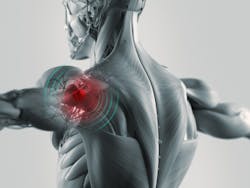The knee is a simple hinge joint that moves the lower leg back and forth on a single plane. By contrast, the shoulder is a complex joint that can move the arm (and itself) in all three dimensions of space.
Many people believe that they are protected from shoulder problems if their job involves hard physical labor. This is false for several reasons, one of which is that labor does not ensure proper joint alignment or balanced muscle development. For the same reason, simply exercising at the gym won’t protect you (although a well-designed program that addresses shoulder symmetry does provide a high degree of protection).
Shoulder problems occur almost always due to repeated small “insults” to the shoulder joint system. The most common factor in shoulder injuries today is chronic misalignment. Instead of following the military drill instructor’s admonition of “Shoulders back, chest out,” today's default mode is shoulders rounded forward. People hunch over their phones and tablets, take a C posture when using a computer, and crane over their work when doing things such as making electrical connections.
Consequently, the rear deltoids (one of the three muscle “heads” in the shoulder) are weakened and elongated; essentially, they are removed from their job of stabilizing the shoulder. The shoulder rotates forward, giving that hunched shoulder appearance.
In this position, the shoulder is prone to injury. Injuries can be nagging, such as frozen shoulder. If you routinely have sore trapezoids (the muscles that connect the neck and shoulder), it is almost certainly because of what therapists refer to as compensation. The median deltoids of the shoulder are not firing because of the posture problem, and the body compensates by firing those trapezoids.
Now the shoulder is set up for atrophy in two of the three muscle heads. Picture a three-legged stool with two legs half-eaten through by termites, and you see the problem.
The root cause is the craning mentioned earlier. While you can reduce or eliminate craning when using devices, you probably cannot eliminate craning when doing electrical tasks in the field.
Reduce craning
We’re told that to avoid eye strain when using a screen device such as a desktop computer, we should look away from the screen every so often. You can apply this same principle to craning. Make a point of coming out of the craned position periodically. Take this to the next level by reversing the crane — pull your chin back, pull your shoulders back, and stick your chest out (just as that military drill sergeant would have you do).
If you find it difficult to hold (or even obtain) this military posture, don’t worry. You can do something else to give your shoulders the relief they need. Imagine you are standing up and pushing your palms against the palms of someone else who is pushing slightly harder than you are; this will push your shoulders back.
You can ask someone to actually do this, or you can simply use a doorjamb.
Stand with your right palm to the jamb and rotate your hips to the left; this will align your scapula. Then repeat on the left side. Do a few more sets of these, and you may eliminate all the tightness in the front of your shoulders while tightening up all the slack in the back. If you do not achieve this effect, do this stretch more often. If you do achieve this effect, do this stretch often enough to maintain it.
However, the exercise does not build shoulder muscles; the goal is to restore proper alignment and, thus, leverage. So, using the same muscle mass you had before, you will have more effective strength — and much more stability. Instead of causing the rotator cuff to carry a load in excess of its design strength and tearing it, you’re allowing the entire shoulder to work as it should.
It takes very little time out of your work day to do these minor “course corrections” for your shoulders. Recovering from rotator cuff surgery can take a year of dedicated rehabilitation. Which way is more time-efficient?
About the Author

Mark Lamendola
Mark is an expert in maintenance management, having racked up an impressive track record during his time working in the field. He also has extensive knowledge of, and practical expertise with, the National Electrical Code (NEC). Through his consulting business, he provides articles and training materials on electrical topics, specializing in making difficult subjects easy to understand and focusing on the practical aspects of electrical work.
Prior to starting his own business, Mark served as the Technical Editor on EC&M for six years, worked three years in nuclear maintenance, six years as a contract project engineer/project manager, three years as a systems engineer, and three years in plant maintenance management.
Mark earned an AAS degree from Rock Valley College, a BSEET from Columbia Pacific University, and an MBA from Lake Erie College. He’s also completed several related certifications over the years and even was formerly licensed as a Master Electrician. He is a Senior Member of the IEEE and past Chairman of the Kansas City Chapters of both the IEEE and the IEEE Computer Society. Mark also served as the program director for, a board member of, and webmaster of, the Midwest Chapter of the 7x24 Exchange. He has also held memberships with the following organizations: NETA, NFPA, International Association of Webmasters, and Institute of Certified Professional Managers.
